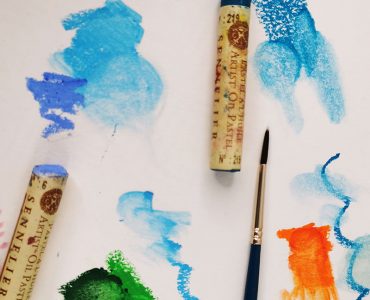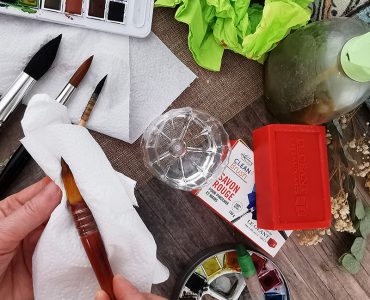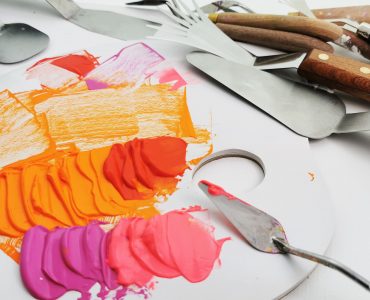An A-Z of Colour
A bit of curiosity turned into some research into the origins and history of different pigments we are used to seeing and those we don’t see so often anymore in their true form. We found that some had more ‘colourful’ stories than others! To give you a little insight into the contents of you palette, we present you with our…

Alizarin Crimson
This pigment was synthesized by German chemists from the organic pigment found in the root of madder plants, as a substitute for ancient colours such as Madder Lake and Rose Madder. The roots were used to colour textiles by the Egyptians and were popular glazing colours which spread well in oil and produced a range of reds from brownish to bluish shades. It was originally developed with the intention of being more lightfast, but has since been found to be less stable than the original pigment. The synthetic colour has many name variations including madder lake and alizarin madder lake due to its origins, so manufacturers often tend to select a name based on their own history.
Burnt Sienna
One of the earth colours, sienna is a clay containing iron oxide which is a yellowish colour when in it is in its natural state. The sienna pigment was used in its natural form as one of the earliest paints found in prehistoric and was one of the standard browns used by artists from the 16th to 19th centuries including Caravaggio and Rembrandt. The Italians enhanced the range of tones produced from the sienna pigment by roasting it, as when heated the iron oxide dehydrates which changes it partially to haematite and gives it a rich reddish, brown colour.
Cadmium Red
Famously used by American minimalist Donald Judd, who favoured Cadmium Red Light for colouring his paintings and sculptures because he believed it revealed all the edges, lines and textures of the work.
Cadmium has been used in oil, acrylic and watercolour paints since the 19th century. As a sulphide it creates the popular cadmium yellow which is then turned orange and red by adding selenium, all of which produce a bright, intense shade which is lightfast. Cadmium colours have been subjected to criticism in recent years with the proposal to ban them from the EU after the Swedish government claimed that by rinsing these colours from brushes in the sink, the harmful substance was making its way into the sewage used as agricultural fertiliser. In reality, the manufacture of artists’ paints makes up a very small part of the world’s cadmium use and it is doubtful that any pollution is caused by painters cleaning equipment. Thankfully the ban was not enforced, and it has been suggested that the disposal of nickel-cadmium batteries in landfills is more likely to be responsible for the contamination. So for now, your Cadmium Red is safe, and excellent for adding warmth and vibrancy to your work.
Dioxazine Violet
The full name for this pigment is Carbazole Dioxazine, and its tinting strength is so strong that in mass tone it appears almost black, and is sometimes used in the manufacture of Indian ink, so a little goes a long way making it ideal for glazes. However, despite its strength it is less lightfast than other violets, so the strength can be sort lived when compared to shades like cobalt and manganese violet.
Emerald Green
Paints sold today under this name are actually created from blends of yellow Phthalo pigments as the true Emerald, Scheele’s or Paris green, is no longer used or available in its original form due to it being highly poisonous. The colour consisted of copper aceto-arsenite, the effects of which were not yet known in the 1800s, when it was not only used for painting, but extremely popular for dying everything from clothes and wallpaper. Fabric dyers, factory workers and wearers of ‘poison’ green clothing suffered arsenic poisoning from the pigment, and there has been speculation that Napoleon died as a result of fumes produced by the wallpaper in his exile home. Truly a colour to die for.
French Ultramarine
For centuries, the only source for this prized pigment was the lapis lazuli stones found in a strip of mountains in Northern Afghanistan making this colour more precious than gold. Because of the cost, the colour was traditionally restricted to being used for the clothing of Christ or the Virgin Mary and Rafael would reserve true ultramarine for the final coat, creating his base layers in a more common shade.
A reward was offered in 1824 to anyone who could successfully develop a synthetic alternative to this much sought after pigment which prompted two men to come forward within several weeks of each other. The prize was contested, but finally awarded to Jean-Baptiste Guimet, a French chemist, much to the irritation of his opposition, a German professor. For this reason, the artificial pigment was known as ‘French Ultramarine.’
Gamboge
This pigment is extracted from the Garcinia Hanburyi tree and its earliest evidence of use if from East Asia in the 8th Century. The trees must be 10 years old and the resin is extracted by making incisions in the bark and breaking of leaves and shoots so the yellow resinous gum can exude and be collected in hollow bamboo. Once the resin sets the bamboo is broken away leaving the solid gamboge which when ground creates a bright yellow powder. The colour is used to dye traditional Buddhist monks’ robes their deep saffron yellow, but the pigment can also range to darker, mustard yellow. Paint colours referred to as ‘New Gamboge’ refer to a synthetized version of the natural pigment.
Hookers Green
This colour is made from a mixture of Prussian blue and gamboge and was developed by botanist William Hooker for his botanical illustration. This particular green replicates natural shades of leaves and helps create a range of natural tones for landscapes. It was used by William Hooker for painting the leaves of fruit and was later popularized by artist John Sell Cotman who made extensive use of it in his painting of Greta Bridge.
The shade is popular in watercolour, but the mixture has an unreliable permanency so newer versions have been created mixing Phthalo blue and cadmium yellow as an improvement on this issue.
Indian Yellow
The production and sale of the natural Indian yellow organic pigment was actually outlawed in the early 20th century, so any shades now available are synthetic versions. The natural version of the pigment was created from cow urine which, to obtain the bright yellow shade, were fed exclusively on mango leaves and water. Their urine was then collected, heated and purified to obtain a solid yellow matter. The colour results from the mango, not the urine itself, and the diet of mango leaves meant the cows were extremely malnourished hence the pigment’s prohibition due to the inhumane treatment.
Jenkins Green
This colour is a mixture and is a rich, warm green created by Golden Artists Colors Inc. for the abstract painter Paul Jenkins who died in 2012. His paintings were fluid, bold, and glowing representations of the power of colour and to create them he developed a method of pouring the paint directly only the canvas in different directions and then guiding it with an ivory blade. Jenkins describes his method as ‘a crapshooter throwing dice.’
‘It’s a big gamble, and that’s why I love it.’

Kings Blue
This name was given to Smalt blue by English manufacturers. The origins of this colour are said to have come from a blue used by ancient Egyptians which contains copper. Smalt gets its colour from cobalt, but both pigments are made from coloured glass and were used as glazes for ceramics. Because it was made from glass the colour was transparent and not very strong so known to fade, particularly if it was ground too finely.
Lead White
This is considered by many oil painters to be the superior white, yet subject to controversy and less available now due to well-known toxicity of lead. Used carefully, in small quantities and in a controlled manner the use of lead whites is not hazardous, but as the use of lead carries some risk it is not recommended for the casual hobby painter. A directive has been passed by the EU which now controls the use of lead paint to limit the risk of lead poisoning. This effects how it can be handled and sold which is why lead whites are more commonly found in cartridges as opposed to tubes.
The pigment is made by corroding the lead with vinegar to create lead carbonate which is then washed and ground. The colour is often referred to as ‘flake white’ as when the lead carbonate is removed from the metal it falls in large flakes ready to be made into powder.
Lead whites were popular because they offer durability, flexibility and a fast drying time and because of its strength only a small amount is required.
Malachite Green
This green is probably the oldest known to art as traces of it have been found in Ancient Egyptian tomb paintings. It was also likely to have been used by them as eye paint, much like the blue pigment from azurite.
In order to create the bright shade of green the particles much be well washed and ground coarsely, as a finely ground powder creates a much paler shade. It is best suited for egg tempera work as the shade is much darker when bound with oil.
Naples Yellow
The properties of the genuine Naples yellow pigment are very similar to those of Flake White, and for that reason Naples yellow has been artificially made since the 15th century using non-toxic substitutes. The origins of the name are not clear, but it like comes from the natural deposit found in the volcanic earth of Mount Vesuvius on the bay of Naples. The tones can range from greenish to red and the colour provides an opaque and permanent quality that meant it was a staple shade in the palette of the old masters.
Ochre
Known to us in variations or yellow, red and brown, ochre is natural earth pigment that has been used in abundance since prehistoric times by many different civilizations. There is a painting in the cave of Lascaux of a horse coloured with yellow ochre is estimated to be around 17,300 years old.
Payne’s grey
Named after its creator, Devon born watercolourist William Payne, who is credited with developing numerous techniques that were considered ‘tricky’ by the artists of his day such as ‘splitting his brush’ when depicting foliage. This shade is his most notable creation, being a combination of Prussian blue, yellow ochre and crimson lake to create a neutral tint with a blueish hue. The modern version is now often a mixture of ultramarine and black of sienna and has been used as a colour names since 1835.
Quinacridone Magenta
This is part of the Quinacridone family of pigments which range from deep red and gold to violet in shade. These pigments are synthetic and considered to be high performance because they are exceptionally colour and weather fast, which is why they are often used cars and industrial purposes. Daniel Smith provides an extensive range of 12 Quinacridone watercolour shades that are meticulously prepared to provide a combination of intense colour and transparency. The pigments are ground superfine with uniform particle size, making their performance faultless.
Raw Umber
Another shade from the family of earth pigments and one of the first pigments used by man. It was less used by Medieval artists who preferred bright colours such as red and green, and was rejected by the impressionists who considered earth pigments, ‘old and dull’, but it was an important pigment during the baroque period and was a staple for palettes of Caravaggio and Rembrandt. Vermeer also used umber to create shadows on white washed walls, to obtain a more harmonious shadow than one created with a black pigment.
Sap Green
Originally made from Buckthorn berries and lacked permanency so many shades today are a mixture combined with phthalocyanine to replicate the original. The berries could be used to make a pink dye when they were ripe but when unripe they produced yellow juice which was used to dye cloth and in between were used for sap green.
Tyrian Purple
This colour was a beautifully rich, red purple that was said to become even more striking when exposed to the sun. A prized and prestigious pigments, it was used to dye Roman ceremonial robes, and taken from an unlikely source, snails. The mollusks used were found off the shore of Phoenicia’s Tyre, and as large quantities were needed to make it, the pigment was very expensive and eventually stopped being produced. Synthetic versions are still available and to our knowledge are snail free.

Vermillion
The name actually comes from the Latin vermis, which means worm, and it was called as such because the scarlet red was a similar colour to a red dye made from an insect. The original pigment was made by grinding powder of the cinnabar mineral, which contains mercury making it toxic. Because of this today’s vermillion shades are mostly synthetic or mixtures but the genuine pigment was used for decoration in Ancient Rome, China and India and was hugely popular during the Renaissance. It was a particularly important colour in China, used for their lacquerware, and became known as ‘Chinese Red’.
Chromium oXide
This was first produced by a colour maker in Paris in 1838, who produced the colour along with his successor for many years keeping the process a closely guarded secret. It became known as viridian and replaced the toxic emerald green in industrial and artists’ uses. Being permanent and safer to use it was an excellent replacement for all ancient green shades and also some modern.
Weld
This is a natural, pure yellow dye taken from the plant Dyer’s Rocket and is the oldest European dye plant. They grow up to five feet high with long spikes of small, yellow flowers. The dye was very concentrated and used for silks and wool before being used as a pigment for oil colour. It still grown and used to dye silks today.

Lemon Yellow
This is blanket term used for 3 shades; Strontium Yellow, Zinc Yellow and Barium yellow, all of which were semi-transparent and used in oil and watercolours. Different artists had different preferences as to what they considered their shade of lemon yellow. Blockx preferred barium yellow which is suggested to have been introduced as a less costly alternative to Platina yellow which was made from platinum.
Zinc White
This shade of white is much cleaner and colder than titanium or white lead, as well as more transparent, which is what makes it so valuable for making tints with other colours, as well as offering the benefit of being non-toxic. It also takes much longer to dry as it requires a much larger quantity of oil to bind the pigment. The draw back with zinc white is that when used pure it creates a brittle paint layer that is prone to cracking, which caused problems in its first uses when it was applied as ground for oil paints. Artists wanted to take advantage of the pure colour provided, but were unaware of the long term impact and after a period of years the paintings developed cracks. It is perfectly safe to use in smaller amounts for colour mixing but it would be unsuitable for grounds of a snow covered landscape for example.
It was introduced to watercolours under the name of ‘Chinese white’, the name coming from the Chinese porcelain that was popular during the 18th and 19th century.
Discover GreatArt’s full range of oils, acrylics, watercolours and gouaches online and in-store!
GreatArt – your art superstore
Art supplies, ideas and advice for all techniques.
GreatArt offers you art supplies for all techniques from:
- traditional fine art painting,
- drawing,
- sculpture
- printmaking,
- graphic art,
- illustration,
- airbrushing,
- model making…
We offer an extensive range of stretched canvas and display products for exhibition, all the art supplies required to create your own bespoke canvases, as well as custom framing and mounting services from GreatArt Store. You’ll also find hundreds of articles and tutorials to browse in the online magazine.





















Add comment